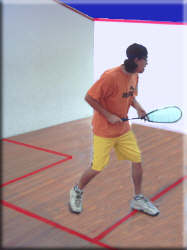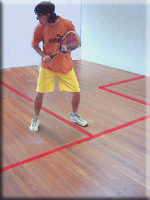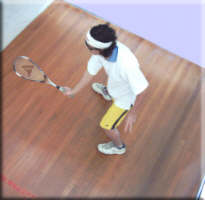Squash Footwork - Court Movement

The main attributes required for good Squash footwork and court movement are:
- Anticipation - The ability to read the speed and direction of the opponent's shot early.
- Speed - Fast take off, movement and recovery
- Balance - Ability to control and coordinate bodily movement during the swing
- Agility - Ability to change direction fluently
- Judgement - Spatial awareness
Get Ready to Take Off
More on Take Off
| ||||||||||||
Take offAnticipation plays a big part when preparing to take off.
Leg power/strength plays a large part in the speed of the take off. More on Take Off
| ||||||||||||
Movement to the Ball
More on Movement to the Ball
|
| Good | Bad |
| I watch the ball at all times | I am slow to get to the ball |
| As the opponent starts to swing I get ready to move | I wait till my opponent hits the ball before I start to move |
| I get to the ball early | I always seem to struggle to return the balls |
| I started skipping each day to increase my speed on court | After a few long rallies my legs feel tired. |
| I warmup and stretch before my match | Sometimes I feel so stiff from the previous match |
Footwork When Striking the Ball

- As the feet and body/shoulders are getting in position to strike the ball it is imperative the racket be in the "ready" to strike position.
- Good balance will assist making this movement smooth and fluent.
More on Footwork while Striking the Ball
 Squashgame Gold: Advanced Text and Video Content
Squashgame Gold: Advanced Text and Video Content
More on Footwork while Striking the Ball
- Ideally the player will arrive to one side of the ball closest to the centre of the court, being able to transfer their weight from the back to the front foot in the motion of striking the ball.
Recovery to T

- Move with a fluent movement, knees relaxed, long strides.
- Keep watching the ball (never turn your back on the ball).
More on Recovery to the T
 Squashgame Gold: Advanced Text and Video Content
Squashgame Gold: Advanced Text and Video Content
More on Recovery to the T
- Ideally the player will arrive to one side of the ball closest to the centre of the court, being able to transfer their weight from the back to the front foot in the motion of striking the ball.
- When recovering from striking the ball keep a low centre of gravity.
- Take long strides.
- Keep good balance.
- Never bring the feet together (as this will decrease the length of the stride) which will cause a loss of time, and jerky movement.
Video clip Back Corner Reovery
Getting the ball out of the back corner
Chasing a ball that is travelling quickly into the back corner can be difficult to recover. Notice in this video some important points:
Chasing a ball that is travelling quickly into the back corner can be difficult to recover. Notice in this video some important points:
- starting off there are a couple of quick steps followed by long strides
- adjustment to footwork
- racket work necessary to get the racket under the ball
Video Resources
Support Squashgame
Support us here at Squashgame.info! If you think we helped you, please consider our Squash Shop when purchasing or make a small contribution.
